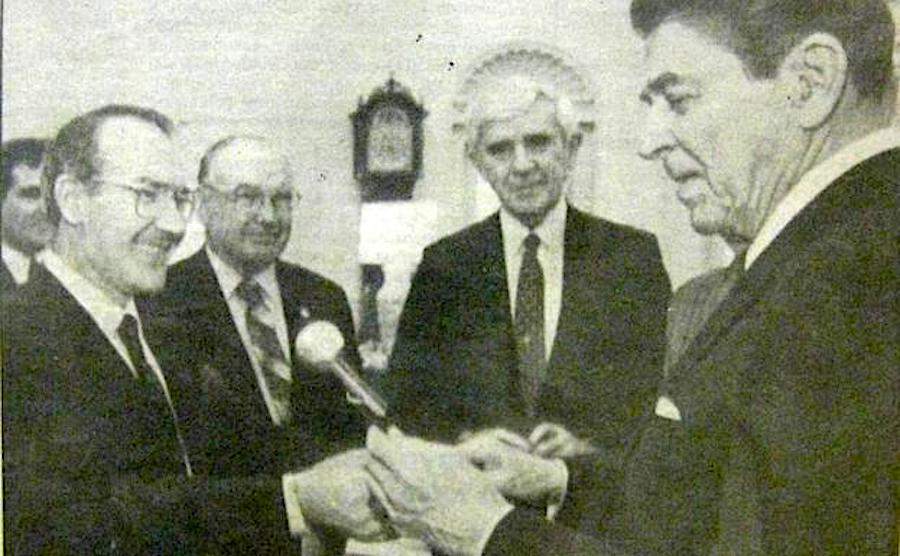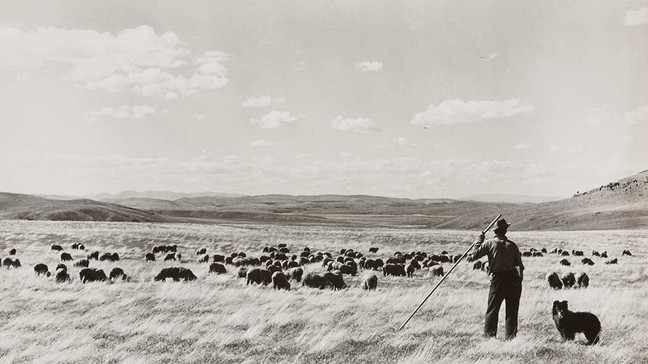On September 25, 1923, Basque-American journalist and author Robert Laxalt was born. We’ve spoken about him on more than one occasion, paying special attention to his extraordinary 37‑page article in the August 1968 issue of National Geographic. Titled “Land of the Ancient Basques,” it included a magnificent selection of photos by William Albert Allard.
Today, six months away from the centenary of Laxalt’s birth, we get the opportunity to speak of him again thanks to two articles recently published about him. The first comes to us from Ray Hagar at the Reno Gazette Journal; the second from John L. Smith at the The Nevada Independent. Both highlight the importance of this writer and events to mark his 100th birthday.
Laxalt, the dean of Basque authors in the US, published his first novel in 1957. Sweet Promised Land was a svelte novel, but by using the skills he honed as a journalist, he was able to introduce Americans to a rich but unknown and often slandered Basque culture, and inserted it into the mosaic of American immigrants.
And he accomplished this by telling the story of his father, Dominique Laxalt, born in 1887 in Atharratze, Soule, who emigrated to the US in 1906. There, in 1921, he married Therese Alpetche, born in Baigorri, Lower Navarre. Robert was the second of their children.
The book not only tells the tale of his father in the US, it also tells of the voyage father and son took in 1953 to Soule and Lower Navarre, which was the author’s first contact with the land of his forebears. Laxalt himself had this to say:
“When I went with Papa to de Basque Country, I fell in love with the place. I couldn’t imagine anybody leaving such a beautiful country. I didn’t take any consideration at all because most of them were poor and they had no opportunities there. ButI had been raised in the desert, so I was totally in a trance when I arrived there. I couldn’t believe it. I was feeling that I had always been there. It was just somewhere in my folk memory. Besides, the people in the Basque Country were beautiful people. I never felt alienated there at all. They were my kind of people: they were strong and forthright”
The importance of this book for the Basque community and its image in American society was explained by Basque Country University North American literature professor David Rio Raigadas in the foreword to the Spanish edition of this book:
«Aunque Laxalt, hijo de un pastor de Zuberoa emigrado a los EE.UU. a principios de siglo, no se ve a sí mismo como el fundador de un género y rechaza los intentos de aquéllos que quieren clasificarlo como escritor étnico o regional, no se puede obviar su decisivo papel en el fin de la invisibilidad literaria, e incluso social, de la diáspora vasca en los Estados Unidos. En efecto, Laxalt con Dulce tierra prometida. Un pastor vasco en el Oeste americano (Sweet Promised Land en su versión original de 1957) no sólo consiguió que las experiencias de los vascos de aquel país tuviesen por primera vez un reflejo literario significativo, sino que logró reivindicar ante los ojos de la sociedad norteamericana la figura del pastor vasco en aquellas tierras. De hecho, los vascos para muchos norteamericanos eran un grupo étnico prácticamente desconocido, al que con cierta frecuencia se acusaba de usurpar la tierra por su dedicación mayoritaria al pastoreo itinerante.
(Though Laxalt, the son of a Soule-born sheepherder who had emigrated to the US at the turn of the century, did not see himself as the founder of a genre, and rejected the attempts of those who tried to classify him as an ethnic or regional writer, his decisive role in ending the literary, and indeed social, invisibility, of the Basque diaspora in the United States cannot be ignored. Indeed, Laxalt, with “Sweet Promised Land,” (1957) not only managed to get the experiences of the Basques in that country to, for the first time, be reflected in literature, he also managed to raise up the figure of the Basque sheepherder in those lands in the eyes of the Americans. In fact, for many Americans, the Basques were a practically unknown group, though they were often accused of usurping land for their majority dedication to roaming grazing.)
The book, translated by Ttarttalo, and it can be found in its digital format on Amazon.
But Laxalt was not key only in putting Basque culture on the map of American culture. He also had a leading role at the University of Nevada, Reno, where he promoted the knowledge and research of the Basques in the western US. As David Rio Raigadas again explains in the foreword to the Spanish edition of the book:
Otro acontecimiento fundamental en el resurgir de la cultura vasca en Norteamérica en el que Laxalt desempeñó un papel relevante fue la creación en 1967 del Programa de Estudios Vascos por parte del Instituto de Estudios de Zonas Áridas (una de las divisiones por aquel entonces del sistema universitario de Nevada). De hecho, Laxalt, junto a William A. Douglass y Jon Bilbao, fue uno de los fundadores de dicho programa. El origen concreto del mismo se remonta a 1960-1961 cuando, a propuesta de tres destacados antropólogos (Robert Heizer, Omer Stewart y Fred Eggan) procedentes de distintas universidades norteamericanas, el Instituto de Estudios de Zonas Áridas decidió poner en marcha un programa de estudios vascos dentro del centro, basándose en la idea de que la figura del pastor vasco representaba un elemento destacado en la historia del Oeste americano.
(Another fundamental event in the resurgence of Basque culture in North America was that Laxalt played a significant role in the creation of the Center for Basque Studies at the Desert Research Institute (one of the divisions of what was then the University of Nevada System). In fact, Laxalt, alongside William A. Douglass and Jon Bilbao, was one of the founders of said program. The specific origin of the same dates back to 1960–61 when, at the behest of three leading anthropologists (Robert Heizer, Omer Stewart, and Fred Eggan) from three different American universities, the Desert Research Institute decided to set up a Basque studies program at the center, based on the idea that the Basque sheepherder represented a leading element of the history of the American West.)
Before leaving you with the articles, we’d like to highlight two interesting facts:
-
- 2023 is the 100th anniversary of the birth of two great Basque-American journalists. They were both born in the Americas not twenty days apart, but 7,000 km (4,500 mi) apart. The first was Robert “Bob” Laxalt. The second was Francisco “Paco” Igartua, about whom we’ve spoken on numerous occasions. The latter was born in Huarochirí, in the inland part of Lima province, on September 5, 1923.


-
- In 1998, Lehendakari Ardanza met with Ronal Reagan, much to the extreme annoyance of Spanish authorities. This meeting was organized by Robert Laxalt’s younger brother, Paul Laxalt, the former governor of Nevada, senator for Nevada, and close personal friend of Reagan. Thus he kept alive the Laxalt tradition to “bother” those in power in Madrid with his commitment to the Basques. Robert Laxalt had already done so in 1968 with his National Geographic article, which we spoke of above; it also cause great distress among Franco’s authorities.
We’ll leave you with both articles
Reno Gazette Journal – 3/3/2023 – USA
Robert Laxalt: remembering one of Nevada’s greatest authors, journalists
Robert Laxalt was born in 1923 into a sheepherder’s family, and his father’s home was the hills of Nevada. From this humble beginning, Laxalt rose to be a giant of American literature, considered to be among Nevada’s “Holy Trinity” of authors, standing with Mark Twain and Walter Van Tilburg Clark.
(Follow) (Automatic translation)
The Nevada Independent – 19/3/2023 – USA
Nevada writer Laxalt’s literary legacy shines at centennial celebration


In the state’s hallowed trinity of celebrated literary figures, Robert Laxalt’s mark on Nevada letters seems the most improbable. A young Sam Clemens, smart-alecky younger brother of the secretary of Nevada Territory, spent a formative but brief stint in Virginia City as an inventive cub reporter for the Territorial Enterprise. He added the pen name Mark Twain and moved on to great acclaim as, “the Lincoln of our literature.” Twain enjoyed his Nevada sojourn so much that he set foot in the state just twice more.
Last Updated on Dec 3, 2023 by About Basque Country





























